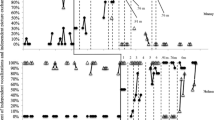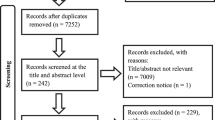Abstract
We evaluated the effects of systematic prompting plus reinforcement on listeners’ independent responses to peer mands and on speakers’ peer-directed mands using the picture exchange communication system (PECS) in two studies. In Study 1, three PECS users with a diagnosis of autism were trained to direct PECS exchanges toward peers, whereas in Study 2, three peers with autism were taught to accept a PECS card, select the requested item from an array of three items, and place it in front of their peer. Study 1 showed an increase in peer PECS mands that generalized to novel trained peers for all participants. Results of Study 2 demonstrated an increase in correct independent responses to PECS exchange for all participants, a response that readily generalized across peers and settings for two out of three participants. These results suggest that this intervention protocol may be an effective way to increase interactions between peers with autism.


Similar content being viewed by others
References
Bayley, N. (2006). Bayley scales of infant and toddler development: Administration manual (3rd ed.). San Antonio, TX: Harcourt Assessment.
Belchic, J. K., & Harris, S. L. (1994). The use of multiple peer exemplars to enhance the generalization of play skills to the siblings of children with autism. Children and Family Behavior Therapy, 16(2), 1–25. https://doi.org/10.1300/J019v16n02_01.
Bondy, A., & Frost, L. (2001). The picture exchange communication system. Behavior Modification, 25(5), 725–744. https://doi.org/10.1177/0145445501255004.
Cannella-Malone, H. I., Fant, J. L., & Tullis, C. A. (2010). Using the picture exchange communication system to increase the social communication of two individuals with severe developmental disabilities. Journal of Developmental and Physical Disabilities, 22(2), 149–163. https://doi.org/10.1007/s10882-009-9174-4.
DiSalvo, C., & Oswald, D. (2002). Peer-mediated interventions to increase the social interaction of children with autism: Consideration of peer expectancies. Focus on Autism and Other Developmental Disabilities, 17(4), 198–207. https://doi.org/10.1177/10883576020170040201.
Edwards, S., Fletcher, P., Garman, M., Hughes, A., Letts, C., & Sinka, I. (1997). The Reynell developmental language scales (3rd ed.). Windsor, UK: NFER-Nelson.
Fisher, W. W., Piazza, C. C., Bowman, L. G., Hagopian, L. P., Owens, J. C., & Slevin, I. (1992). A comparison of two approaches for identifying reinforcers for persons with severe and profound disabilities. Journal of Applied Behavior Analysis, 25, 491–498. https://doi.org/10.1901/jaba.1992.25-491.
Gonzalez-Lopez, A., & Kamps, D. M. (1997). Social skills training to increase social interactions between children with autism and their typical peers. Focus on Autism and Other Developmental Disabilities, 12(1), 2–14. https://doi.org/10.1177/108835769701200101.
Hancock, T. B., & Kaiser, B. (1996). Siblings’ use of milieu teaching at home. Topics in Early Childhood Special Education, 16(2), 168–190. https://doi.org/10.1177/027112149601600204.
Kazdin, A. E. (2010). Single-case research designs: Methods for clinical and applied settings. New York, NY: Oxford University Press.
Kodak, T., Paden, A., & Dickes, N. (2012). Training and generalization of peer-directed mands with non-vocal children with autism. The Analysis of Verbal Behavior, 28(1), 119–124. https://doi.org/10.1007/BF03393112.
Koegel, L. K., Park, M. N., & Koegel, R. L. (2014). Using self-management to improve the reciprocal social conversation of children with autism spectrum disorder. Journal of Autism and Developmental Disorders, 44(5), 1055–1063. https://doi.org/10.1007/s10803-013-1956-y.
Lorah, E. R., Gilroy, S. P., & Hineline, P. N. (2014). Acquisition of peer manding and listener responding in young children with autism. Research in Autism Spectrum Disorders, 8(2), 61–67. https://doi.org/10.1016/j.rasd.2013.10.009.
Michael, J. (1993). Establishing operations. The Behavior Analyst, 16(2), 191–206. https://doi.org/10.1007/BF03392623.
Paden, A. R., Kodak, T., Fisher, W. W., Gawley-Bullington, E. M., & Bouxsein, K. J. (2012). Teaching children with autism to engage in peer-directed mands using a picture exchange communication system. Journal of Applied Behavior Analysis, 45(2), 425–429. https://doi.org/10.1901/jaba.2012.45-425.
Pellecchia, M., & Hineline, P. N. (2007). Generalization of mands in children with autism from adults to peers. The Behavior Analyst Today, 8(4), 483–491. https://doi.org/10.1037/h0100634.
Roid, G. H. (2003). Stanford–Binet intelligence scales (5th ed.). Itasca, IL: Riverside.
Skinner, B. F. (1957). Verbal behavior. New York, NY: Appleton-Century-Crofts.
Sparrow, S., Cicchetti, D. V., & Balla, D. A. (2005). Vineland adaptive behavior scales (2nd ed.). Circle Pines, MN: AGS Publishing.
Taylor, B. A., Hoch, H., Potter, B., Rodriguez, A., Spinnato, D., & Kalaigian, M. (2005). Manipulating establishing operations to promote initiations towards peers in children with autism. Research in Developmental Disabilities, 26(4), 385–392. https://doi.org/10.1016/j.ridd.2004.11.003.
Thiemann-Bourque, K. (2012). Peer-mediated AAC instruction for young children with autism and other developmental disabilities. SIG 12 Perspectives on Augmentative and Alternative Communication, 21(4), 159–166. https://doi.org/10.1044/aac21.4.159.
Wechsler, D. (2002). Wechsler preschool and primary scale of intelligence (3rd ed.). San Antonio, TX: Harcourt Assessment.
Acknowledgements
The authors would like to thank the participants and their families for their part in this study. We would also like to acknowledge the contribution of the staff of PALS preschool for their part in conducting study trials and data collection.
Author information
Authors and Affiliations
Corresponding author
Ethics declarations
Conflict of Interest
Amanda Doherty and Laura Gormley were employed by the host institution at the time of the study.
Ethical Approval
All procedures performed in the study were in accordance with the ethical standards of the School of Psychology Ethics Committee of Trinity College Dublin, and with the 1964 Helsinki declaration and its later amendments.
Informed Consent
Informed consent and assent was obtained from all individuals and their parents/guardians in the study.
Additional information
Research Highlights
• Children with autism can learn to direct PECS mands toward their peers.
• Prompting and reinforcement can be used to teach children with autism to respond correctly to peer PECS mands for a variety of stimuli.
• Responses to peer PECS mands indicated generalization across both peers and settings and maintenance at follow-up for the majority of participants.
Rights and permissions
About this article
Cite this article
Doherty, A., Bracken, M. & Gormley, L. Teaching Children with Autism to Initiate and Respond to Peer Mands Using Picture Exchange Communication System (PECS). Behav Analysis Practice 11, 279–288 (2018). https://doi.org/10.1007/s40617-018-00311-8
Published:
Issue Date:
DOI: https://doi.org/10.1007/s40617-018-00311-8




